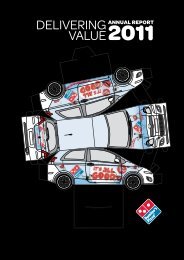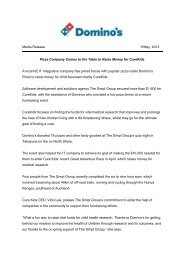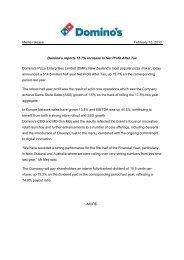2012 Annual Report - Domino's Pizza
2012 Annual Report - Domino's Pizza
2012 Annual Report - Domino's Pizza
Create successful ePaper yourself
Turn your PDF publications into a flip-book with our unique Google optimized e-Paper software.
NOTES TO THE FINANCIAL STATEMENTS CONTINUED<br />
3.17 Leasing<br />
Leases are classified as finance leases<br />
whenever the terms of the lease transfer<br />
substantially all the risks and rewards<br />
incidental to ownership of the leased<br />
asset to the lessee. All other leases<br />
are classified as operating leases.<br />
3.17.1 Consolidated entity as lessee<br />
Assets held under finance leases are initially<br />
recognised as assets of the Consolidated entity<br />
at their fair value at the inception date of the<br />
lease or, if lower, at the present value of the<br />
minimum lease payments. The corresponding<br />
liability to the lessor is included in the statement<br />
of financial position as a finance lease obligation.<br />
Lease payments are apportioned between<br />
finance expenses and reduction of the lease<br />
obligation so as to achieve a constant rate<br />
of interest on the remaining balance of the<br />
liability. Finance expenses are recognised<br />
immediately in profit or loss, unless they are<br />
directly attributable to qualifying assets, in<br />
which case they are capitalised in accordance<br />
with the Consolidated entity’s general policy on<br />
borrowing costs (see 3.16 above). Contingent<br />
rentals are recognised as an expense in<br />
the periods in which they are incurred.<br />
Finance leased assets are amortised<br />
on a straight-line basis over the<br />
estimated useful life of the asset.<br />
Operating lease payments are recognised as an<br />
expense on a straight-line basis over the lease<br />
term, except where another systematic basis<br />
is more representative of the time pattern in<br />
which economic benefits from the leased asset<br />
are consumed. Contingent rentals arising under<br />
operating leases are recognised as an expense<br />
in the period in which they are incurred.<br />
In the event that lease incentives are<br />
received to enter into operating leases,<br />
such incentives are recognised as a liability.<br />
The aggregate benefits of incentives are<br />
recognised as a reduction of rental expense<br />
on a straight-line basis, except where another<br />
systematic basis is more representative of<br />
the time pattern in which economic benefits<br />
from the leased asset are consumed.<br />
3.18 Goodwill<br />
At cost less accumulated<br />
impairment losses, if any:<br />
Goodwill arising in a business combination<br />
is recognised as an asset at the date that<br />
the control is acquired (the acquisition date).<br />
Goodwill is measured as the excess of the<br />
sum of the consolidation transferred, the<br />
amount of any non-controlling interests<br />
in the acquiree, and the fair value of the<br />
acquirer’s previously held equity interest<br />
in the acquiree (if any) over the net of the<br />
acquisition-date amounts of the identifiable<br />
assets acquired and the liabilities incurred.<br />
If, after reassessment, the Consolidated entity’s<br />
interest in the fair value of the acquiree’s<br />
identifiable net assets exceeds the sum of<br />
the consideration transferred, the amount of<br />
any non-controlling interests in the acquiree<br />
and the fair value of the acquirer’s previously<br />
held equity interest in the acquiree (if any),<br />
the excess is recognised immediately in<br />
profit or loss as a bargain purchase gain.<br />
On disposal of a subsidiary, the attributable<br />
amount of goodwill is included in the<br />
determination of the profit or loss on disposal.<br />
Review of potential impairment:<br />
Goodwill is not amortised but is reviewed for<br />
impairment at least annually. For the purpose of<br />
impairment testing, goodwill is allocated to each<br />
of the Consolidated entity’s cash-generating<br />
units expected to benefit from the synergies<br />
of the combination. Cash-generating units to<br />
which goodwill has been allocated are tested<br />
for impairment annually or more frequently<br />
when there is an indication that the unit may<br />
be impaired. If the recoverable amount of the<br />
cash-generating unit is less than the carrying<br />
amount, the impairment loss is allocated first<br />
to reduce the carrying amount of any goodwill<br />
allocated to the unit and then to the other<br />
assets of the unit pro-rata on the basis of the<br />
carrying amount of each asset in the unit.<br />
An impairment loss recognised for goodwill<br />
is not reversed in a subsequent period.<br />
3.19 Intangible assets<br />
3.19.1 Intangible assets acquired separately<br />
Intangible assets acquired separately are carried<br />
at cost less accumulated amortisation and<br />
accumulated impairment losses. Amortisation<br />
is recognised on a straight-line basis over their<br />
estimated useful lives. The estimated useful<br />
life and amortisation method are reviewed<br />
at the end of each annual reporting period,<br />
with the effect of any changes in estimates<br />
being accounted for on a prospective basis.<br />
3.19.2 Internally-generated intangible assets<br />
– research and development expenditure<br />
Expenditure on research activities<br />
is recognised as an expense in the<br />
period in which it is incurred.<br />
An internally-generated intangible asset<br />
arising from development (or from the<br />
development phase of an internal project)<br />
is recognised if, and only if, all of the<br />
following have been demonstrated:<br />
• the technical feasibility of completing<br />
the intangible asset so that it will<br />
be available for use or sale;<br />
• the intention to complete the<br />
intangible asset and use or sell it;<br />
• the ability to use or sell the intangible asset;<br />
• how the intangible asset will generate<br />
probable future economic benefits;<br />
• the availability of adequate technical,<br />
financial and other resources to<br />
complete the development and to use<br />
or sell the intangible asset; and<br />
• the ability to measure reliably the<br />
expenditure attributable to the intangible<br />
asset during its development.<br />
The amount initially recognised for internallygenerated<br />
intangible assets is the sum of the<br />
expenditure incurred from the date when the<br />
intangible asset first meets the recognition<br />
criteria listed above. Where no internallygenerated<br />
intangible asset can be recognised,<br />
development expenditure is recognised in profit<br />
or loss in the period in which it is incurred.<br />
Subsequent to initial recognition, internallygenerated<br />
intangible assets are reported at cost<br />
less accumulated amortisation and accumulated<br />
impairment losses, on the same basis as<br />
intangible assets acquired separately.<br />
The following useful lives are used in the<br />
calculation of amortisation:<br />
• Capitalised development<br />
intangibles<br />
2 – 5 years (i)<br />
• Licenses<br />
2 – 5 years<br />
(i) Management has assessed certain<br />
capitalised development intangibles to<br />
have a useful life of up to 10 years.<br />
3.19.3 Intangible assets acquired<br />
in a business combination<br />
Intangible assets acquired in a business<br />
combination are identified and recognised<br />
separately from goodwill and are initially<br />
recognised at their fair value at the acquisition<br />
date (which is regarded as their cost).<br />
Subsequent to initial recognition,<br />
intangible assets acquired in a business<br />
combination are reported at cost less<br />
accumulated amortisation and accumulated<br />
impairment losses, on the same basis as<br />
intangible assets acquired separately.<br />
40<br />
ANNUAL REPORT <strong>2012</strong> DOMINO’S PIZZA ENTERPRISES LIMITED













